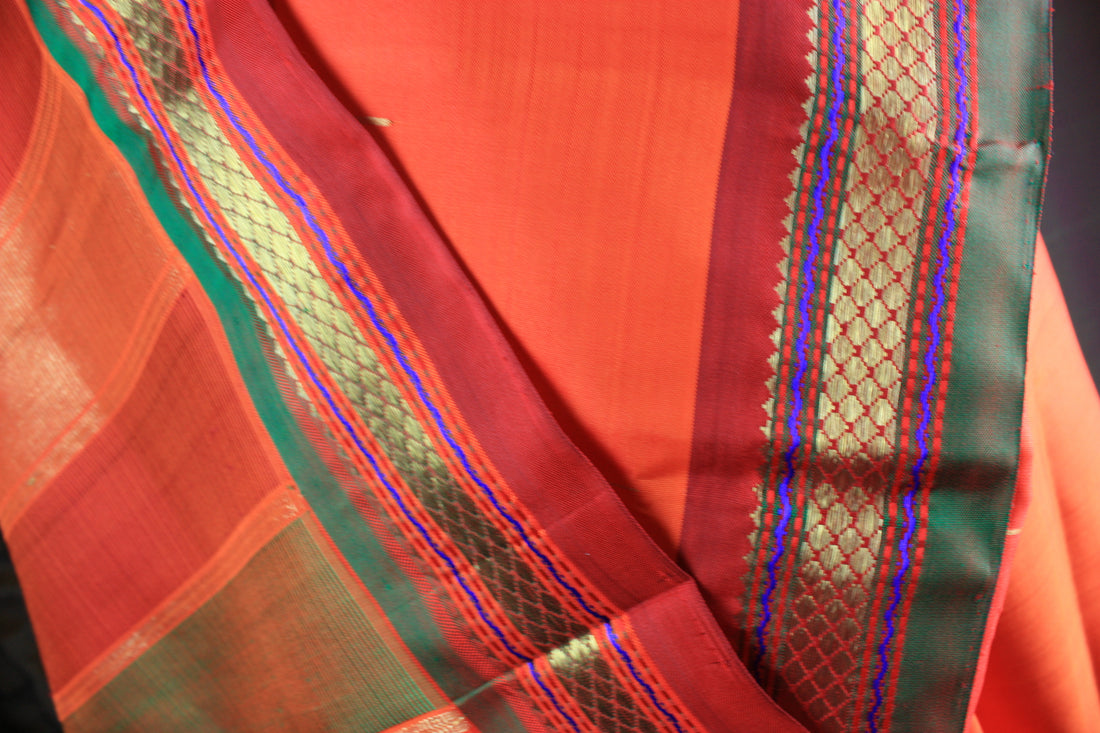South Indian traditional jewelry is so distinctive just like its counterpart, Kanjivaram Handloom. You can find many motifs inspired by jewelry in this weave which is prevalent in bridal; and temple jewelry which is worn traditionally by the Bharatanatyam dancers.

Muthu Vari (line of pearls) - A line formed by tiny dots. Each dot represents a muthu or pearl.

Muthu Kattam (pearl checks) - Checks formed by tiny dots throughout the body of the saree. The dots are so uniformly placed that you can easily miss the gaps if you don’t look closely and mistake them to be a solid line. Interestingly, the size of these checks are a half inch square which would perfectly fit a pearl.
Muthu Seer (pearl gifts) - A row of muthu varis or pearl lines usually found in the pallu of the saree. In Tamil, Seervarisai refers to the gifts given to the bride by her parents.
Pavunpet (Gold coin) - A circular coin formed by Vs in 4 directions put together. This motif is very similar to the Rudraksha motif but you can distinguish it by a dot in the center.
Vairam (diamond) - A diagonal checkered pattern formed by tiny rhombus shaped dots. This is usually found in the borders or pallu of the saree. To me, the glitter produced by this formation looks like diamonds. It also reminds me of the traditional vaira thodu (diamond studs) setting.

Vaira oosi (diamond needle) - Lines formed by thin needle-like dots usually made by zari.These lines are usually parallel to the border of the saree and spaced very close together. They are so fine that you can easily miss them if you don’t look close. They play so interestingly with the body color of the saree and add a spectacular lustre.

Salangai (anklet with bells) - A linear pattern formed by a row of floral motifs joined together by a curvy line which looks like little bells dangling from an anklet. These are usually found framing the inside edge of the border of the saree.

Vanki (zig zag line/ armlet) - A pattern formed by a row of zig zag lines. They represent a traditional inverted V shaped armlet ornament. This is usually found on the border or the pallu of the saree.

Jadai nagam (Braid serpent) - A heart shaped pattern representing the hood of a snake. Jadai nagam is a hair ornament which is worn on the braid. Its top portion looks like the hood of a serpent.
Neli (wavy line) - A wavy line which usually runs parallel to the border of the saree, sometimes along the entire body. It represents the metti or the toe rings. There are also rettai neli or double wavy lines which look like the padi kolam or border rangoli usually put on the threshold.

Veldhari (wavy line with dot) - A neli or wavy line with dots inside the curves on either side. This is supposed to represent the Vel or spear of Lord Murugan. This pattern is so enchanting and I can’t imagine the planning and precision which goes into weaving these beautiful motifs!


1 comment
Such an insightful post on bridal fashion trends! I’ve always admired how timeless and elegant a kanjeevaram south indian bridal saree looks for weddings. The craftsmanship and vibrant colors truly make it a perfect choice for brides who want tradition with style.
https://www.aikyatha.com./